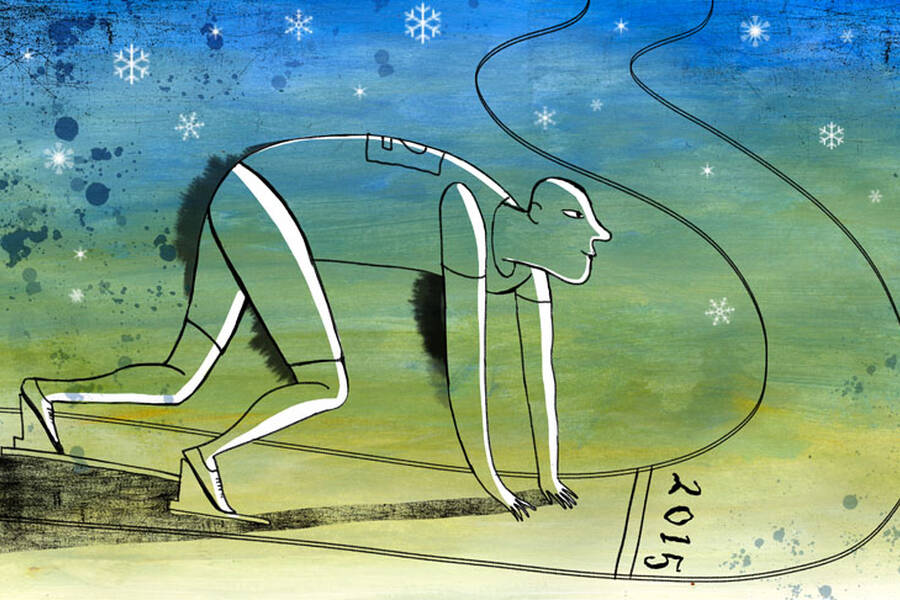Marketing Social Impact Apr 4, 2016
A 10:30 Cupcake? Don’t Mind If I Do
Both consumers and marketers can benefit from knowing when self-control is lowest.

Yevgenia Nayberg
We all want to think well of ourselves, whether we are alone at home resisting an impulse buy from Amazon.com or surrounded by colleagues at lunch trying to stick to our diet.
Self-control can have a major influence on self-image. When we resist that unnecessary purchase or pass on a second slice of cake, we behave in a way that is in line with our values, and we feel good about ourselves.
But we are bombarded with opportunities to splurge, and despite our best efforts, we cannot exercise self-control all the time. A bit of slacking is inevitable. And according to new research from the Kellogg School, it is more likely to occur when we are in the middle of something.
“Actions at the beginning and end of a sequence appear to reflect more on our own personal standards than actions in the middle,” says Maferima Touré-Tillery, an assistant professor of marketing.
That is, we believe that straying from our goals when we are in the middle of a given sequence, whether real or imagined, does not do as much damage to our self-image as succumbing when we first begin, or with the finish line is in sight. It is a finding with implications for everything from personal finance to public health policy.
“Appealing to a person’s desire to think of herself in positive terms proves to be a powerful motivator in the arduous pursuit of long-term goals.”
Mischievous Middle
In a study published a few years ago, Touré-Tillery and Ayelet Fishbach, of the University of Chicago, found that people are more likely to adhere to rules, standards, or traditions at the beginning and end of a sequence of tasks in their pursuit of a goal. For example, Jewish participants were more likely to light Hanukah candles during the first and last nights of the eight-day holiday than during the middle.
The research distinguishes between two dimensions of motivation: outcome-focused motivation, which is the motivation to get it done, and means-focused motivation, which is the motivation to do it right.
“Means-focused motivation is in the service of maintaining a positive image of the self, so we can continue to think of ourselves as good people,” Touré-Tillery says. While the motivation to “get it done” can follow a variety of patterns, Touré-Tillery’s work shows that the motivation to “do it right” is highest at the beginning and end versus in the middle.
Why beginnings and ends? Because they are transitions or break points, we naturally pay more attention to them. In experiments, people are more likely to remember items at the beginning and end of lists than those in the middle. So what we do at the beginning or end weighs more heavily on how we judge both ourselves and others. For example, behaving unethically at the beginning or the end of a sequence is seen as stronger evidence of a dishonest character than if the same transgression were made in the middle. We are familiar, after all, with the importance of making a good first impression and ending on a positive note.
A new study by the same researchers suggests that, even in the absence of real sequences, people rely on the mere notions of beginnings and ends, or first and last to inform their own self-image. And because we judge ourselves more harshly at the beginning or the end of a task, we are also more motivated to keep our long-term goals in mind then.
Caffeine and Candy
In one experiment, the researchers recruited 98 coffee drinkers near a coffee shop. They were shown a “buy 9, get the 10th free” punch card with either one, five, or eight holes punched. Then they were asked to imagine that they had been on a “coffee detox” in an effort to cut back on their caffeine. How bad would they feel about themselves if they nonetheless gave into their temptation to buy a caffeinated coffee?
Participants who were at the beginning or end of their punch cards—that is, people with either a single punch or eight punches—felt worse about purchasing that coffee than those who were in the middle of their punch card. This happened even though the numbers of punches was unrelated to how long the person had been on the detox.
The trend even held when the beginning, middle and end were somewhat arbitrarily assigned to a sequence of time.
In another experiment, the researchers placed Kit Kat bars and raisin packets on a table in a business school hallway. From a previous survey, the researchers knew that two-thirds of MBA students surveyed at the school considered healthy eating to be important.
For the experiment, a different poster hung behind the table around lunchtime each day, reading either, “Start your afternoon! Grab a snack,” “Keep your day going! Grab a snack,” or “End your morning! Grab a snack.”
Of the 163 MBA students who unknowingly participated, 22 percent chose the healthy snack after seeing the middle “keep your day going” message, compared with 40 percent who saw the “start” message and 46 percent who saw the “end” message.
The results show that framing something as being at the beginning or end of an arbitrarily selected time period “promotes self-control,” Touré-Tillery says.
The Importance of Goals in Self-Control
A key factor in how susceptible people are to these manipulations is how committed they are to a specific goal, which is an indication of how much their self-image is tied to achieving that goal. Take fiscal responsibility, for example.
The researchers had 223 undergraduate students complete a survey that assessed their level of commitment to financial goals and asked how much they would be willing to pay for various items. The participants filled out one of three surveys titled either, “Start of quarter shopping,” “Middle of year shopping,” or “End of quarter shopping.”
Participants were willing to spend less money at the beginning or end compared with the middle, but only when saving money was important to them. Strikingly, people were equally willing to splurge in the middle condition, regardless of their level of commitment to financial goals. Another experiment looked at people with healthy-eating goals and showed similar results.
“Taken together, the findings show that people who are strongly committed to a goal are more likely to exercise restraint when they think that their behavior is more reflective of their self-image,” meaning at the beginning or end of a time frame, Touré-Tillery says.
How to Frame Messages
The findings could have powerful implications for marketers who, with a few simple wording changes, could dial up or down their audience’s willingness to abandon health goals or spend money. For example, a candy-bar commercial could announce, “Keep your day going!” or a car dealership might have more success on Labor Day weekend by announcing, “Unbeatable mid-year deals!”
By the same token, public health campaigns could boost their impact by framing their messages at the beginning or end of a sequence. For example, antismoking ads could urge addicts to “Start a new beginning” or “End the year with positive change.”
Touré-Tillery hopes this research is used to bring out the best in people. Triggering people to be more aware of their own self-image by framing something as happening at the beginning or end may encourage them to make positive changes in their lives. This could be an important step toward combating worldwide rises in personal debt or the global obesity epidemic.
Although the current research focused on health, financial, and intellectual goals, the researchers expect their findings to hold in any context that poses a trade-off between short-term desires and long-term interests.
“On a practical note, our findings suggest educators, parents, managers, and public policy makers could promote greater adherence to important goals by triggering concerns about self-image,” Touré-Tillery says. “Appealing to a person’s desire to think of herself in positive terms proves to be a powerful motivator in the arduous pursuit of long-term goals.”
Touré-Tillery, Maferima, and Ayelet Fishbach. 2015. “It Was(n’t) Me: Exercising Restraint when Choices Appear Self-diagnostic. Journal of Personality and Social Psychology.



